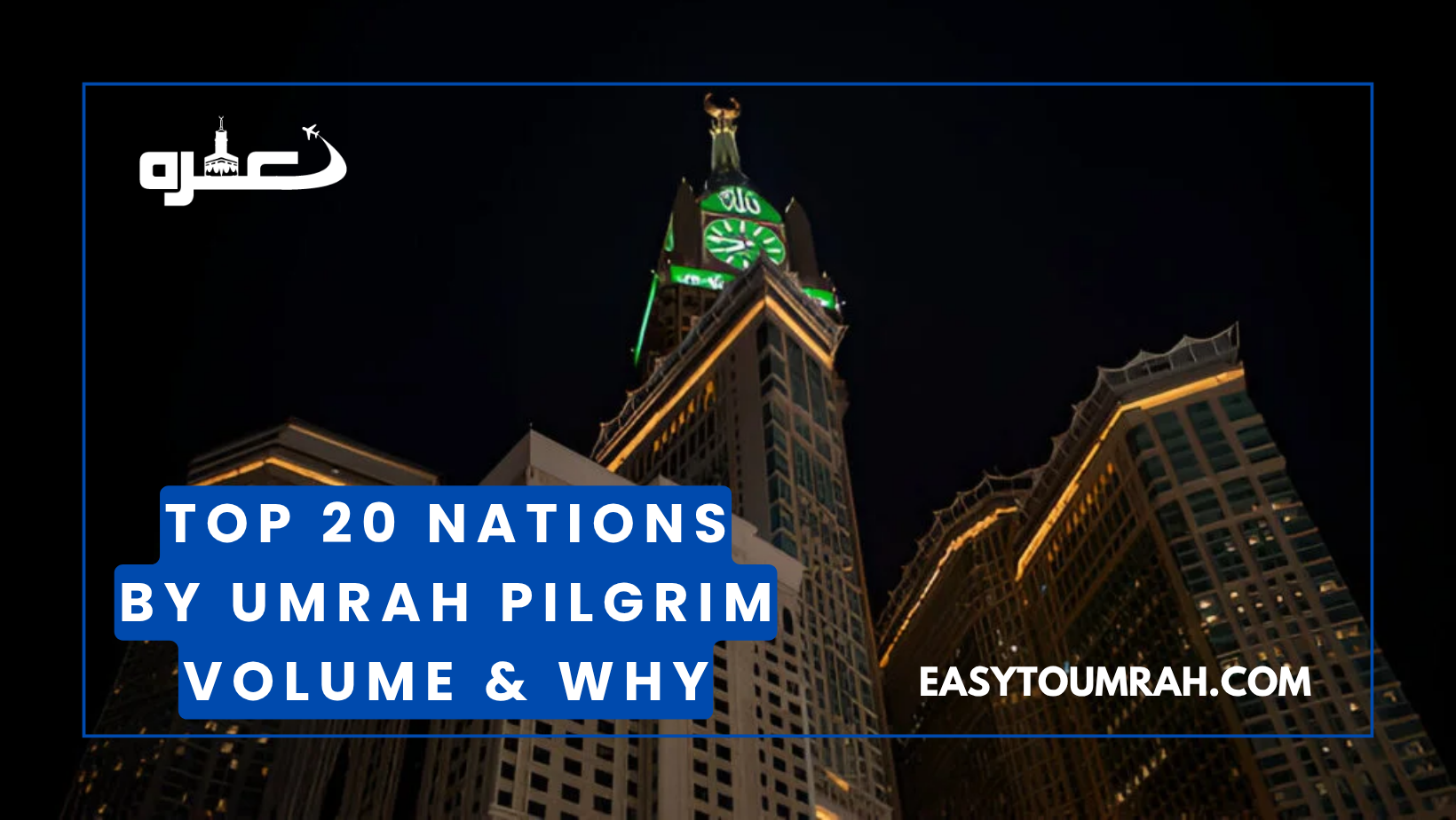Top 20 Nations by Umrah Pilgrim Volume
& Why They Visit
A Deep Dive into Global Umrah Travel Patterns
Introduction
Each year millions of Muslims from around the world travel to undertake Umrah, the pilgrimage of lesser stature compared to Hajj, but nonetheless deeply significant. With the Kingdom of Saudi Arabia’s major expansion and infrastructure upgrades under its Vision 2030, the number of international Umrah performers has surged. In 2024, roughly 16.92 million foreign pilgrims performed Umrah, representing a 101% increase compared to 2022. In this article we analyse the top 20 nations sending Umrah pilgrims, why they rank high, and what trends and factors shape this global religious travel.
Top 20 Countries Performing Umrah & Why They Lead
Note: Exact national rankings for all 20 nations are not always publicly broken down; the data here draws from available official reports, press releases and pilgrim-experience statistics.
1. Indonesia
Indonesia is among the highest in Umrah pilgrim numbers. According to one source, in 2024 people from Indonesia numbered ~1,055,615.
Why:
-
Largest Muslim-majority nation by population → large base of potential pilgrims.
-
Strong organising networks, Umrah-focused travel agencies.
-
Geographic offering of direct flights and package deals.
-
Cultural encouragement and high religious motivation among the population.
2. Pakistan
In 2024, Pakistan reportedly sent ~2,005,031 Umrah pilgrims.
Why:
-
Large Muslim population and high religious devotion to the pilgrimage.
-
Proximity (relatively) and strong linkages with Saudi Arabian visa and travel infrastructure.
-
Competitive travel packages and collective group bookings.
-
Many first-time and repeat pilgrims motivated by spiritual duty.
3. India
India has also witnessed fast growth: from ~804,266 in 2023 to ~1,420,118 in 2024.
Why:
-
One of the largest Muslim minority populations globally.
-
Many Indian Muslims view Umrah as a highly spiritual aspiration beyond Hajj quotas.
-
Improved travel connectivity and visa facilitation.
4. Egypt
Egypt’s figures: ~1,347,318 in 2022 rising to ~1,762,825 in 2023.
Why:
-
Historic ties with the Hejaz region; Arabic language and cultural proximity.
-
Established pilgrim networks and travel agencies with years of experience.
5. Bangladesh
Bangladesh sent ~348,221 in 2022 and ~516,799 in 2023.
Why:
-
Large Muslim population and increasing incomes enabling travel.
-
Strong domestic demand for pilgrimage beyond Hajj quotas.
6. Turkey
Turkey’s growth is remarkable – from ~125,783 in 2022 to ~518,616 in 2023 (312% growth).
Why:
-
Muslim-majority and strong cultural-religious affinity with Mecca and Medina.
-
Good transport links, visa facilitation, and high awareness of religious tourism.
7. Algeria
Algeria rose from ~158,710 in 2022 to ~470,149 in 2023 (196% growth).
Why:
-
French-speaking North African country with strong tradition of pilgrimage.
-
Growing middle class making pilgrimage more accessible.
8. Iraq
Iraq recorded ~474,486 in 2022 and ~593,964 in 2023 (25% growth).
Why:
-
Deep historical religious ties, especially among Shia population, to Hejaz and Hijaz region.
-
Many pilgrims avail group travel and are committed despite logistical challenges.
9. Yemen
Yemen’s numbers: ~411,000 in 2022 rising to ~617,000 in 2023 (50% growth).
Why:
-
Strong religious devotion and tradition of pilgrimage despite local economic and logistical difficulties.
-
Often group-travel via land/sea and air from neighbouring regions.
10. Uzbekistan
In 2024 Uzbekistan saw ~461,500 pilgrims, making it among top 10 globally for Umrah.
Why:
-
Central Asian Muslim-majority country with emerging travel infrastructure.
-
Improved coordination between Uzbek and Saudi authorities for visas and accommodation.
11-20. Additional High-Volume Nations
While detailed numbers for all 20 nations are not always publicly available, other notable countries include Morocco, Malaysia, Jordan, Algeria (already listed), Nigeria, Turkey (listed), and likely others from Southeast Asia and Africa. For example, Malaysia and Morocco are frequently mentioned among high-volume Umrah-sending countries.
General drivers for these nations:
-
Muslim-majority or large Muslim populations.
-
Improving economic conditions making pilgrimage travel feasible.
-
Enhanced visa facilitation by Saudi Arabia (including Umrah e-visa, digital platforms).
-
Strong travel-agency networks specialising in Umrah packages.
-
Cultural or historical ties to the Hejaz region.
-
Improved transport connectivity (air/land/sea) and Saudi infrastructure catering to pilgrims.
Key Trends & Insights
-
Visa & Digital Facilitation: Saudi Arabia’s adoption of digital platforms like the Nusuk app and streamlined Umrah visa processes help remove barriers to pilgrimage.
-
Infrastructure & Expansion: The Kingdom’s expansion of the two holy cities (Mecca and Madinah) and enhancements in pilgrim services underpin the surge in numbers.
-
Seasonality & Peak Periods: Many nations time their Umrah travel in Ramadan or off-peak months for cost and crowd advantages.
-
Economic Growth & Middle Class Rising: As disposable incomes rise in many Muslim-majority countries, pilgrimage becomes a higher priority and more accessible.
-
Cultural & Spiritual Motivation: For many Muslims, performing Umrah is a profound spiritual act—whether first-time, repeat, or combined with Hajj aspiration.
-
Geopolitical / Regional Factors: Sometimes geopolitical shifts (e.g., visa access, diplomatic relations) impact which nations send more pilgrims. For example, easing of restrictions increased access for certain countries.
Frequently Asked Questions (FAQs)
Q1. What is Umrah and how is it different from Hajj?
A: Umrah is a pilgrimage to the holy cities of Mecca and Madinah that can be undertaken at any time of the year and includes rituals such as Ihram, Tawaf and Saʿī. Hajj is an obligatory pilgrimage at specific dates (the 8th-12th of Dhul-Hijjah) for those who meet its criteria.
Q2. Which country sends the most Umrah pilgrims?
A: Recent data show that countries like Pakistan, Indonesia and India are among the highest senders. For example, Pakistan sent ~2,005,031 pilgrims in 2024.
Q3. Why have the numbers of Umrah pilgrims increased recently?
A: Key reasons include: improved visa/digital service facilitation by Saudi Arabia, expansion of pilgrim infrastructure, rising middle classes in Muslim countries, better travel connectivity, and strong religious motivation among Muslims worldwide.
Q4. Are the pilgrimage numbers evenly distributed across all countries?
A: No. The top ~10 nationalities account for roughly 75% of total foreign Umrah pilgrims as per the Saudi Pilgrim Experience Program.
Q5. When is the best time (in terms of crowd and cost) to perform Umrah from my country?
A: While many factors depend on your country’s specific travel packages and peak travel seasons, generally off-peak months (outside Ramadan, peak school holiday periods) tend to be less crowded and slightly more cost-effective. Booking in advance, and choosing weekdays rather than weekends can help.
Q6. How can travelers from Pakistan (or other high-volume nations) prepare efficiently for Umrah?
A: Key steps:
-
Select a reliable travel agency experienced in Umrah.
-
Ensure your visa, flights, accommodation and transport are arranged ahead.
-
Consider timing: check crowd levels, hotel proximity to Haram, and transfers.
-
Familiarise yourself with the rituals, local climate (Mecca/Madinah), and Saudi regulations (Ihram rules, health/vaccination, luggage).
-
Budget properly: accommodation close to Haram will cost more; travel during less busy periods may help reduce cost and crowd exposure.
Conclusion
The global trend of Umrah travel is rising significantly, driven by large Muslim-populations in nations such as Indonesia, Pakistan, India, Egypt, Bangladesh and Uzbekistan, combined with Saudi Arabia’s infrastructure and service enhancements. Understanding which nations send the most pilgrims, and why, gives insightful context for travel-agents, marketers, policy-makers and pilgrims themselves. By optimising content around keywords like “top Umrah countries”, “Umrah pilgrims statistics”, and “why pilgrims travel for Umrah”, this article aligns with semantic-search best practices and captures deep searcher intent—from data-driven insights to planning tips.



